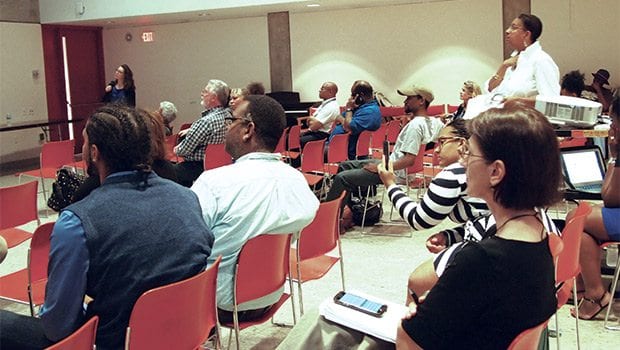
A coalition of Roxbury groups are making a case for a Dudley-Eliot Square Cultural District — a designation they hope will enhance the neighborhood’s cultural scene. Cultural district advocates are in the midst of preparing their case, which will culminate with submitting a formal application to the Massachusetts Cultural Council this September. While energy has recently galvanized, the idea of a Roxbury cultural district has been under discussion for more than a decade, Kelley Chunn told the Banner. Chunn is the principal of Kelley Chunn & Associates, which became a consultant on the project this past March.
Securing cultural district status could boost tourism and economic activity, increase residents’ awareness of their local offerings, give the neighborhood more control over its narrative and character and ensure that as the development boom plays out, space is kept for the arts, some community members say.
At their third public forum, held at Dudley Library last week, organizers explored some hard questions still to be settled: How does Roxbury want to identify its culture, and, critically, how will a cultural district be governed and financially sustained?
On the web
Boston Creates Cultural Plan: http://plan.bostoncreates.org/
Spearheading the effort to prepare a formal application are Haley House, Madison Park Development Corporation and The American City Coalition. The three groups teamed up in 2015 to join the ongoing discussion and explore practicalities; since then, other organizations have stepped forward in support.
When considering eligibility as a cultural district, the Massachusetts Cultural Council looks for areas with a dense concentration of commercial, arts and historical features in a walkable area. Julie Burros, the city’s chief of Arts and Culture, said in a phone interview with the Banner that Boston has no set cultural district model, with its two current ones modeling very different approaches. The Boston Literary Cultural District is organized around a theme and over a large geography, while Fenway Cultural District more focused on highlighting existing cultural assets in a part of the neighborhood. The city works with communities on developing cultural districts.
Economics
Too many of Roxbury’s cultural assets remain overlooked by tourists and local Bostonians, thus failing to tap into what could be a significant revenue stream, organizers stated in a November 2015 application to the Catalyst Fund for financial support.
“The area’s cultural assets remain relatively unknown to those outside of the neighborhood, and few Bostonians, or the millions of annual domestic and international tourists and business travelers, visit the neighborhood,” the application stated.
Burros noted as well that Roxbury in particular has a high concentration of historic sites that are not well known.
“One thing unique to Roxbury is its rich history — it has a lot of historic assets that I would say are in need of higher visibility,” she said.
In addition to helping artists, improving the promotion and ease of discovery of what the areas have to offer could increase weekend and evening traffic, boosting patronage of local businesses and increasing the vibrancy of the area for both local residents and visitors, advocates say.
Defining a neighborhood
With development interest hot in all neighborhoods, and the Boston Redevelopment Authority’s PLAN Dudley due to release a plan in August, the cultural planning represents another level on which community members seek to define and shape their neighborhood before outside forces do.
“It’s always better to pick you own name, to brand yourself rather than have somebody else brand you,” Roxbury resident Rodney Singleton told the Banner in a phone interview.
Through identifying how to present, preserve and promote the neighborhood’s history and art, community members can have greater control of the narrative. At the meeting, Chunn said that attendees have expressed interest in making African American culture a theme for the district. The group’s funding application also states interest in highlighting the area’s immigrant populations from Central and South America, the Caribbean and Africa.
Joyce Stanley, executive director of Dudley Square Main Streets, spoke as an attendee at the meeting, saying that Dudley Square is defined by its diversity.
“When I think of Dudley, I think of how most of my merchants are immigrants. Everything from Russia, Somali, Korea, Pakistan, Sierra Leone, Jamaica, Nigeria — to me that’s part of the flavor,” she said.
Some of the cultural district effort aligns with projects such as the Boston Jazz Trail and Roxbury Memory Trail. Attendees also suggested that areas of note include houses of historical figures, ethnic foods, and memorials for people who have been killed.
Another piece: Keeping artists in the community. With high rental prices in the city, artists struggle both to find a place to live and to secure space to work on their art and showcase it. Chunn said part of tackling this could be ensuring that developer’s linkage funds also go toward supporting spaces for cultural and artistic uses, not just housing.
Making it happen
Many questions remain regarding governance structure, including board size, structure, terms and frequency of meetings. One thing that is certain, Chunn said, is that there will need to be committees on marketing, programming, event planning and budgeting.
The state cultural district designation comes with a $5,000 seed money grant, but to be solvent, the cultural district will need a continued revenue stream. Grant-writing will be key, Chunn said.
Other districts charge membership dues in exchange for networking and promotional opportunities, such as inclusion of a company’s logo on their site, or of an artist in a directory. Chunn suggested charging dues on a sliding scale, with large for-profits paying the most and scholarship opportunities to individual students. The recently-created Boston Literary District charges rates that currently range from free to $3,200, she said.
Boston at large
The city took its own look at some of the same questions around funding for artists throughout Boston. In collaboration with civic leaders, residents and members of arts, cultural and business communities, the city released last Friday its Boston Creates Cultural Plan, which outlines goals and short, mid- and long-term actions to bolster arts and culture locally.
Based on community response, researchers identified that major concerns are artists’ and cultural group’s struggles to attain or maintain affordable housing and work and display or performance space, as well as funding their work. Residents also reported difficulty accessing art and culture as well as finding out about events and offerings. The Dudley-Eliot Cultural District team found a similar concern, with artists reporting a strong desire for the creation of a database listing artists and their activities.
Short-term steps include an initiative to direct one percent of general borrowing toward public art as part of large city construction or infrastructure projects, to be piloted in fiscal year 2017, which starts in July, and a pilot project under which private companies and organizations would allow spare room in their buildings to be used as rehearsal space. The Boston Housing Authority stated plans to set aside units for artists in redevelopments
Starting in August, artists will be able to apply each month for small grants of up to $1,000 to help them showcase their work, Burros said. In the spring, artist fellowship grants to in the range of $5,000 to $10,000 are expected to open.
The Boston Foundation will provide $500,000 annually for three years in a newly-established “Catalyze Creativity” pooled fund for artists and small entities engaged in dance and theater. The Barr Foundation will contribute $250,000 to the fund’s initial year.
The Boston Creates team continues to look for further solutions. To this purpose, The Boston Foundation will fund development of a strategy for providing housing and work space to artists. The report also presents intentions to seek a sustainable, designated revenue stream for arts and culture.






